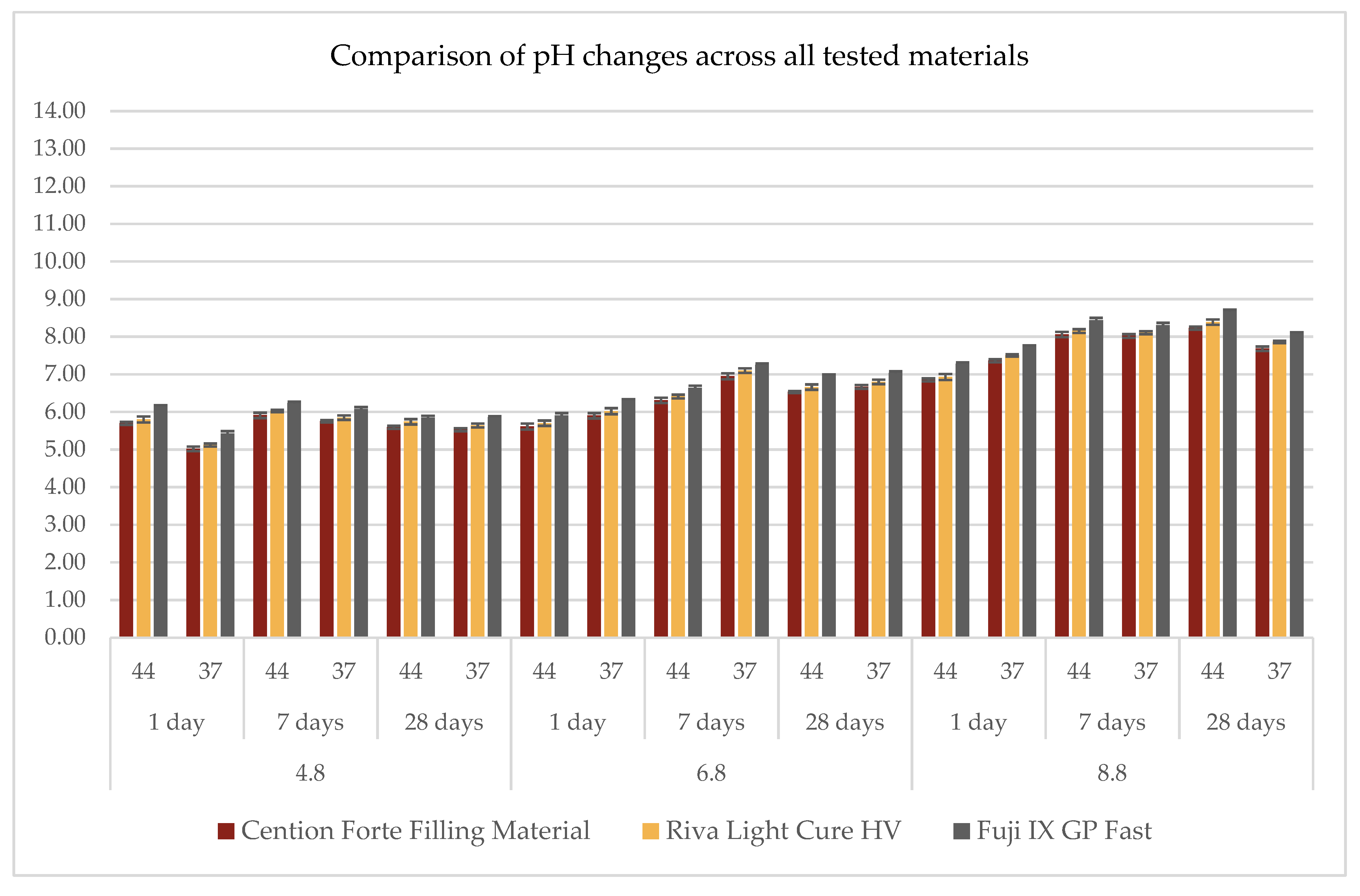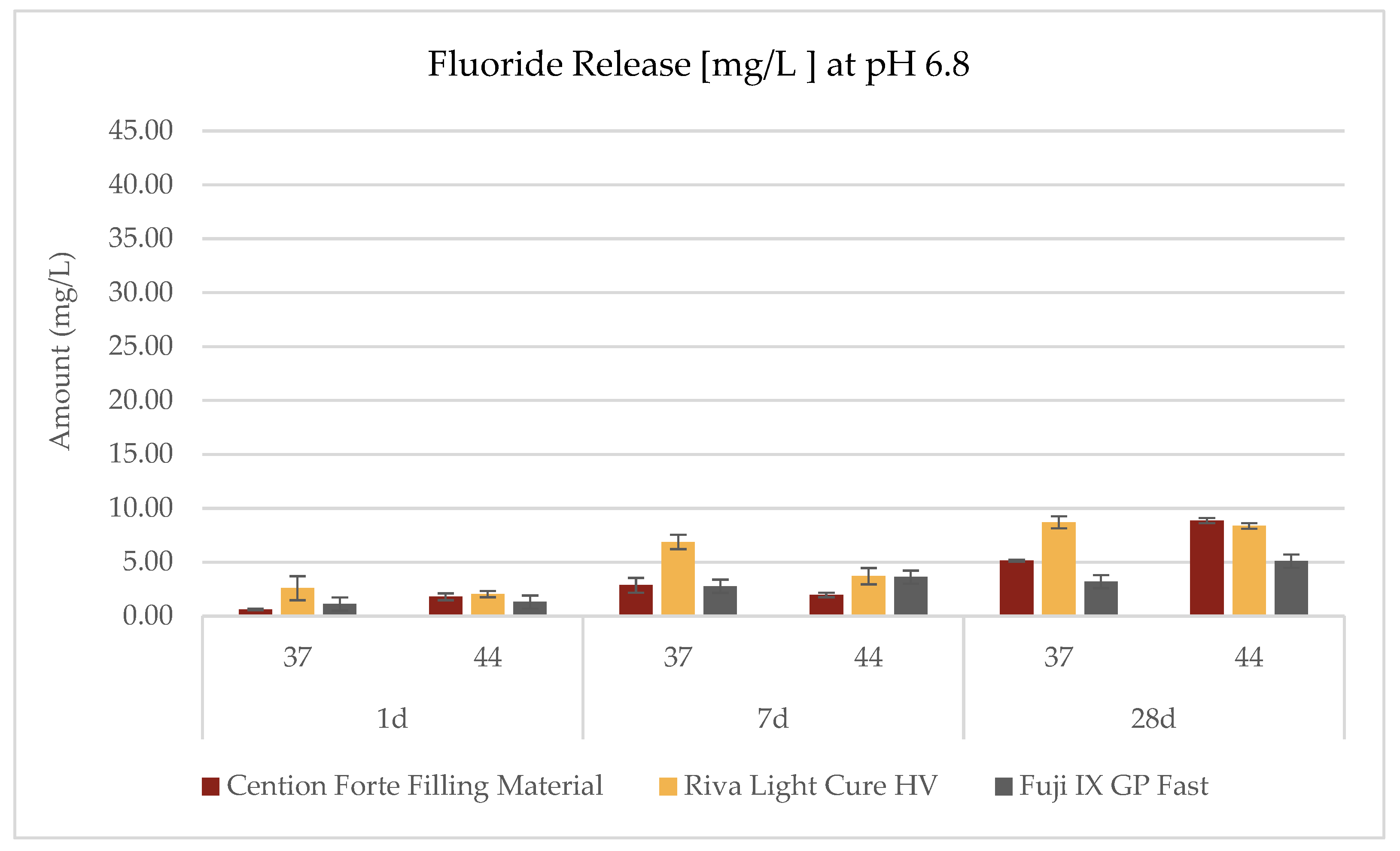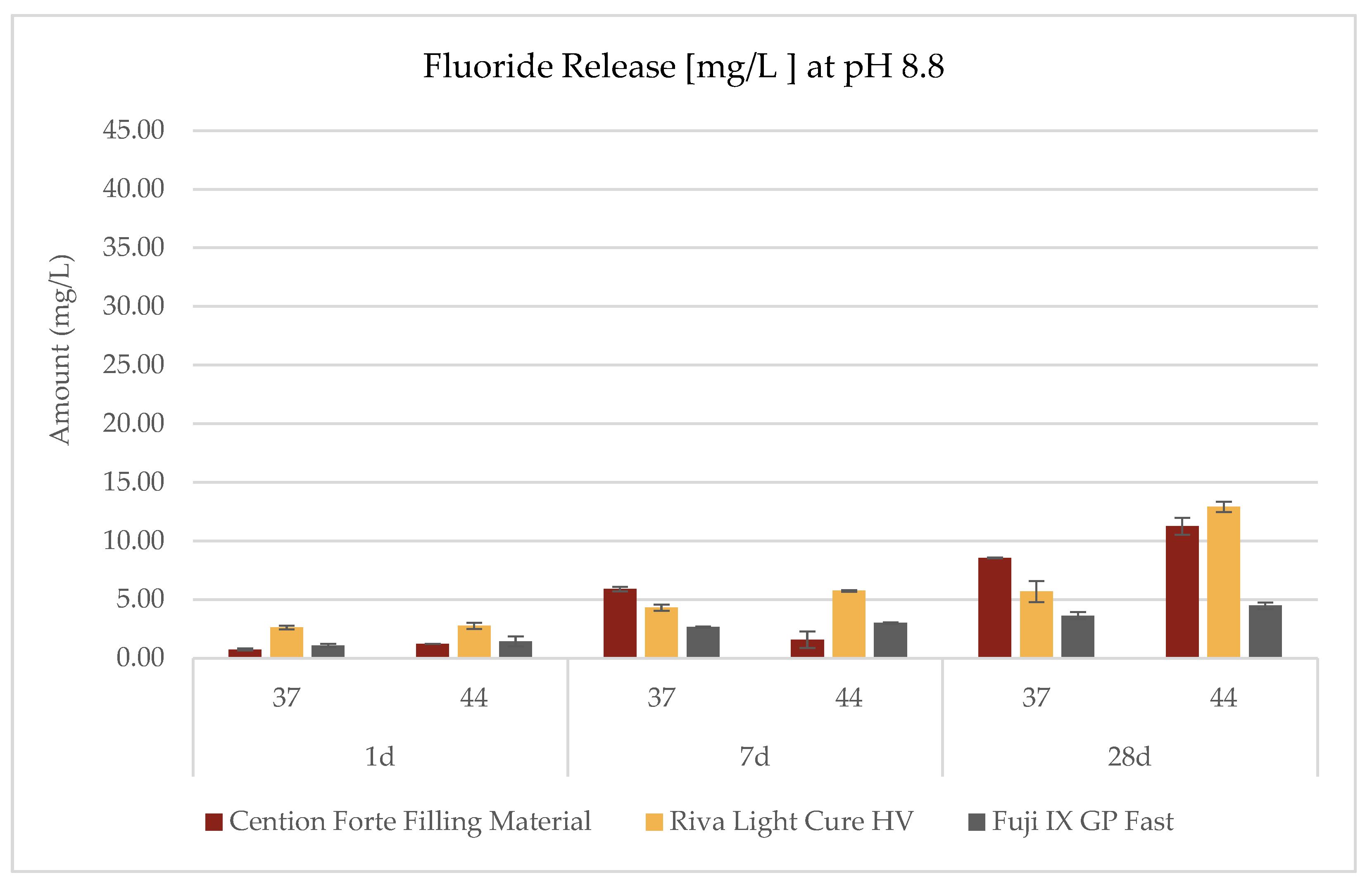Fluoride Release from Pediatric Dental Restorative Materials: A Laboratory Investigation
Abstract
1. Introduction
2. Materials and Methods
2.1. Sample Preparation
2.2. Material Testing Conditions
2.2.1. pH Measurement and Evaluation
2.2.2. Fluoride Release Evaluation
2.3. Statistical Analysis
3. Results
3.1. pH Measurements
3.2. Fluoride Release
4. Discussion
5. Conclusions
Author Contributions
Funding
Institutional Review Board Statement
Informed Consent Statement
Data Availability Statement
Conflicts of Interest
References
- Petersen, P.E.; Bourgeois, D.; Ogawa, H. The global burden of oral diseases and risks to oral health. Bull. World Health Organ. 2005, 83, 661–669. [Google Scholar] [PubMed]
- Klai, S.; Altenburger, M.; Spitzmüller, B. Antimicrobial effects of dental luting glass ionomer cements on Streptococcus mutans. Sci. World J. 2014, 2014, 807086. [Google Scholar] [CrossRef] [PubMed]
- Bogale, B.; Engida, F.; Hanlon, C.; Prince, M.J.; Gallagher, J.E. Dental caries experience and associated factors in adults: A cross-sectional community survey within Ethiopia. BMC Public. Health 2021, 21, 180. [Google Scholar] [CrossRef]
- Lara, J.S.; Romano, A.; Murisi, P.U.; Tedesco, T.K.; Mendes, F.M.; Soto-Rojas, A.E.; Alonso, C.; Campus, G. Impact of early childhood caries severity on oral health-related quality of life among preschool children in Mexico: A cross-sectional study. Int. J. Paediatr. Dent. 2022, 32, 334–343. [Google Scholar] [CrossRef]
- Meyer, F.; Enax, J. Early Childhood Caries: Epidemiology, Aetiology, and Prevention. Int J Dent. 2018, 22, 1415873. [Google Scholar] [CrossRef]
- Chen, K.J.; Gao, S.S.; Duangthip, D.; Lo, E.C.M.; Chu, C.H. Prevalence of early childhood caries among 5-year-old children: A systematic review. J. Investig. Clin. Dent. 2019, 10, e12376. [Google Scholar] [CrossRef]
- Tripodi, D.; Cosi, A.; Valloreo, R.; Fulco, D.; Tieri, M.; Alberi Auber, L.; D’Ercole, S. Association between salivary/microbiological parameters, oral health and eating habits in young athletes. J. Int. Soc. Sports Nutr. 2025, 22, 2443018. [Google Scholar] [CrossRef]
- Zhang, Y.; Bian, C.; Yu, C.; Zhu, M.; Weir, M.D.; Xu, H.H.K.; Bai, Y.; Zhang, N. Bidirectional association between oral diseases caused by plaque and the inflammatory bowel disease: A systematic review and meta-analysis. Jpn. Dent. Sci. Rev. 2025, 61, 7–21. [Google Scholar] [CrossRef]
- Schmoeckel, J.; Gorseta, K.; Splieth, C.H.; Juric, H. How to Intervene in the Caries Process: Early Childhood Caries—A Systematic Review. Caries Res. 2020, 54, 102–112. [Google Scholar] [CrossRef]
- BaniHani, A.; Santamaría, R.M.; Hu, S.; Maden, M.; Albadri, S. Minimal intervention dentistry for managing carious lesions into dentine in primary teeth: An umbrella review. Eur. Arch. Paediatr. Dent. 2022, 23, 667–693. [Google Scholar] [CrossRef]
- Schmoeckel, J. Updates on Caries Management in the Primary and Permanent Dentition. Medicina 2025, 61, 316. [Google Scholar] [CrossRef] [PubMed]
- Francois, P.; Fouquet, V.; Attal, J.P.; Dursun, E. Commercially Available Fluoride-Releasing Restorative Materials: A Review and a Proposal for Classification. Materials 2020, 13, 2313. [Google Scholar] [CrossRef]
- Guo, T.; Wang, D.; Gao, S.S. The antibiofilm effect and mechanism of silver nanowire-modified glass ionomer cement against multi-species oral biofilm. BMC Oral. Health 2025, 25, 160. [Google Scholar] [CrossRef]
- Song, A.; Gong, H.; Zhang, J.; Wang, H.; Zhu, S.; Cui, Z. Enhancing glass-ionomer cements with flake-shaped glass: A new frontier in dental restoration. J. Biomed. Mater. Res. A 2025, 113, e37780. [Google Scholar] [CrossRef]
- Sulimany, A.M.; Aldowsari, M.K.; Bin Saleh, S.; Alotaibi, S.S.; Alhelal, B.M.; Hamdan, H.M. An In Vitro Assessment of the Shear Bond Strength of Alkasite Restorative Material in Primary Molars Compared with Glass Ionomer and Resin-Modified Glass Ionomer Restorations. Materials 2024, 17, 6230. [Google Scholar] [CrossRef]
- Ge, K.X.; Yu-Hang Lam, W.; Chu, C.H.; Yu, O.Y. Updates on the clinical application of glass ionomer cement in restorative and preventive dentistry. J. Dent. Sci. 2024, 19, S1–S9. [Google Scholar] [CrossRef]
- Khoroushi, M.; Mousavinasab, S.M.; Keshani, F.; Hashemi, S. Effect of resin-modified glass ionomer containing bioactive glass on the flexural strength and morphology of demineralized dentin. Oper. Dent. 2013, 38, E1–E10. [Google Scholar] [CrossRef]
- Bhavana, K.; Uloopi, K.S.; Vinay, C.; Chaitanya, P.; Ramesh, M.V.; Ahalya, P. A Randomized Controlled Trial Evaluating the Clinical Performance of Bioactive Restorative Material and Resin-modified Glass Ionomer Cement in Carious Primary Molar Restorations. Int. J. Clin. Pediatr. Dent. 2024, 17, 1109–1113. [Google Scholar]
- Aliberti, A.; Di Duca, F.; Triassi, M.; Montuori, P.; Scippa, S.; Piscopo, M.; Ausiello, P. The Effect of Different pH and Temperature Values on Ca2+, F−, PO43−, OH−, Si, and Sr2+ Release from Different Bioactive Restorative Dental Materials: An In Vitro Study. Polymers 2025, 17, 640. [Google Scholar] [CrossRef]
- Kunert, M.; Piwonski, I.; Hardan, L.; Bourgi, R.; Sauro, S.; Inchingolo, F.; Lukomska-Szymanska, M. Dentine Remineralisation Induced by “Bioactive” Materials through Mineral Deposition: An In Vitro Study. Nanomaterials 2024, 14, 274. [Google Scholar] [CrossRef]
- Maciel Pires, P.; Ionescu, A.C.; Pérez-Gracia, M.T.; Vezzoli, E.; Soares, I.P.M.; Brambilla, E.; de Almeida Neves, A.; Sauro, S. Assessment of the remineralisation induced by contemporary ion-releasing materials in mineral-depleted dentine. Clin. Oral. Investig. 2022, 26, 6195–6207. [Google Scholar] [CrossRef] [PubMed]
- di Lauro, A.; Di Duca, F.; Montuori, P.; Dal Piva, A.M.O.; Tribst, J.P.M.; Borges, A.L.S.; Ausiello, P. Fluoride and Calcium Release from Alkasite and Glass Ionomer Restorative Dental Materials: In Vitro Study. J. Funct. Biomater. 2023, 14, 109. [Google Scholar] [CrossRef]
- Wiegand, A.; Buchalla, W.; Attin, T. Review on fluoride-releasing restorative materials—Fluoride release and uptake characteristics, antibacterial activity and influence on caries formation. Dent. Mater. 2007, 23, 343–362. [Google Scholar] [CrossRef] [PubMed]
- Tokarczuk, D.; Tokarczuk, O.; Kiryk, J.; Kensy, J.; Szablińska, M.; Dyl, T.; Dobrzyński, W.; Matys, J.; Dobrzyński, M. Fluoride Release by Restorative Materials after the Application of Surface Coating Agents: A Systematic Review. Appl. Sci. 2024, 14, 4956. [Google Scholar] [CrossRef]
- Morawska-Wilk, A.; Kensy, J.; Kiryk, S.; Kotela, A.; Kiryk, J.; Michalak, M.; Grychowska, N.; Fast, M.; Matys, J.; Dobrzyński, M. Evaluation of Factors Influencing Fluoride Release from Dental Nanocomposite Materials: A Systematic Review. Nanomaterials 2025, 15, 651. [Google Scholar] [CrossRef]
- Piati, G.C.; Silva, D.B.G.; Delbem, A.C.B.; Martorano, A.S.; Raucci, L.M.S.C.; de Oliveira, P.T.; Zucolotto, V.; Dias, B.J.M.; Brighenti, F.L.; de Oliveira, A.B.; et al. Phosphorylated chitosan and nano-sized TMP: Enhancing strength, antibiofilm action, and biocompatibility of restorative glass ionomer cements. J. Dent. 2025, 156, 105675. [Google Scholar] [CrossRef]
- Boffano, P.; Nikolovska, V.; Melle, A.; Stathopoulos, P.; Ruslin, M. Correlation between fluoride release, surface hardness and diametral tensile strength of restorative glass ionomer cements. J. Clin. Exp. Dent. 2024, 16, e1284–e1290. [Google Scholar] [CrossRef]
- Albasso, A.S.; Ali, R.R.; Yahya, A.A. In vitro evaluation of some mechanical properties and fluoride release of glass-ionomer cement modified with seashell nanoparticles. J. Dent. Res. Dent. Clin. Dent. Prospect. 2024, 18, 165–171. [Google Scholar] [CrossRef]
- Aljohani, A.A.; Alarifi, A.I.; Almoain, M.F.; Alrhaimi, F.F.; Alhejji, M.T.; Gazzaz, N.W.; Ali, L.S.; Alammari, H.D.; Alwattban, R.R.; Alharbi, H.M.; et al. Managing Early Childhood Caries: A Comparative Review of Preventive and Restorative Approaches. Cureus 2024, 16, e74704. [Google Scholar] [CrossRef]
- Jaganath, B.M.; Krishnegowda, S.C.; Rudranaik, S.; Ajakkala, P.S. Comparative Evaluation of Fluoride Release from Glass Ionomer Cement Modified with Different Concentrations of Chitosan: An in vitro Study. Int. J. Dent. Mater. 2024, 6, 37–40. [Google Scholar] [CrossRef]
- Newman, B.H.; Martin, C.A. The effect of hot beverages, cold beverages, and chewing gum on oral temperature. Transfusion 2001, 41, 1241–1243. [Google Scholar] [CrossRef] [PubMed]
- Lachenmeier, D.W.; Lachenmeier, W. Injury Threshold of Oral Contact with Hot Foods and Method for Its Sensory Evaluation. Safety 2018, 4, 38. [Google Scholar] [CrossRef]
- Ausiello, P.; Ciaramella, S.; Lanzotti, A.; Ventre, M.; Borges, A.L.; Tribst, J.P.; Dal Piva, A.; Garcia-Godoy, F. Mechanical behavior of Class I cavities restored by different material combinations under loading and polymerization shrinkage stress. A 3D-FEA study. Am. J. Dent. 2019, 32, 55–60. [Google Scholar]
- Pfeifer, C.S.; Lucena, F.S.; Tsuzuki, F.M. Preservation Strategies for Interfacial Integrity in Restorative Dentistry: A Non-Comprehensive Literature Review. J. Funct. Biomater. 2025, 16, 42. [Google Scholar] [CrossRef]
- Zhang, O.L.; Niu, J.Y.; Yin, I.X.; Yu, O.Y.; Mei, M.L.; Chu, C.H. Bioactive Materials for Caries Management: A Literature Review. Dent. J. 2023, 11, 59. [Google Scholar] [CrossRef]
- Ausiello, P.; Ciaramella, S.; De Benedictis, A.; Lanzotti, A.; Tribst, J.P.M.; Watts, D.C. The use of different adhesive filling material and mass combinations to restore class II cavities under loading and shrinkage effects: A 3D-FEA. Comput. Methods Biomech. Biomed. Eng. 2021, 24, 485–495. [Google Scholar] [CrossRef]
- Santos, M.J.M.C.; Zare, E.; McDermott, P.; Santos Junior, G.C. Multifactorial Contributors to the Longevity of Dental Restorations: An Integrated Review of Related Factors. Dent. J. 2024, 12, 291. [Google Scholar] [CrossRef]
- di Lauro, A.E.; Ciaramella, S.; Tribst, J.P.M.; Aliberti, A.; Ausiello, P. Comparison of Bulk Polymeric Resin Composite and Hybrid Glass Ionomer Cement in Adhesive Class I Dental Restorations: A 3D Finite Element Analysis. Polymers 2024, 16, 2525. [Google Scholar] [CrossRef]
- Zhou, S.L.; Zhou, J.; Watanabe, S.; Watanabe, K.; Wen, L.Y.; Xuan, K. In vitro study of the effects of fluoride-releasing dental materials on remineralization in an enamel erosion model. J. Dent. 2012, 40, 255–263. [Google Scholar] [CrossRef]
- Nassar, Y.; Brizuela, M. The Role of Fluoride on Caries Prevention; StatPearls Publishing: Treasure Island, FL, USA, 2023. [Google Scholar]
- El-Adl, E.T.; Ebaya, M.M.; Habib, E.E.; Zaghloul, N.M. Comparative measurement of short-term fluoride release and inhibition of caries around restoration by ion releasing restorative materials: An in vitro study. Sci. Rep. 2025, 15, 1600. [Google Scholar] [CrossRef]
- Ozer, F.; Patel, R.; Yip, J.; Yakymiv, O.; Saleh, N.; Blatz, M.B. Five-year clinical performance of two fluoride-releasing giomer resin materials in occlusal restorations. J. Esthet. Restor. Dent. 2022, 34, 1213–1220. [Google Scholar] [CrossRef] [PubMed]
- Hicks, J.; Garcia-Godoy, F.; Donly, K.; Flaitz, C. Fluoride-releasing restorative materials and secondary caries. J. Calif. Dent. Assoc. 2003, 31, 229–245. [Google Scholar] [CrossRef]
- Gururaj, M.; Shetty, R.; Nayak, M.; Shetty, S.; Kumar, C.V. Fluoride releasing and uptake capacities of esthetic restorations. J. Contemp. Dent. Pract. 2013, 14, 887–891. [Google Scholar]
- Birant, S.; Gümüştaş, B. The effect of thermal aging on microhardness and SEM/EDS for characterization bioactive filling materials. BMC Oral. Health 2024, 24, 1142. [Google Scholar] [CrossRef]
- Ramos, N.B.P.; Felizardo, K.R.; Berger, S.B.; Guiraldo, R.D.; Lopes, M.B. Comparative study of physical-chemical properties of bioactive glass ionomer cement. Braz. Dent. J. 2024, 35, e245728. [Google Scholar] [CrossRef]
- Kelić, K.; Par, M.; Peroš, K.; Šutej, I.; Tarle, Z. Fluoride-Releasing Restorative Materials: The Effect of a Resinous Coat on Ion Release. Acta Stomatol. Croat. 2020, 54, 371–381. [Google Scholar] [CrossRef]
- Roberts, A.E.; Kragh, K.N.; Bjarnsholt, T.; Diggle, S.P. The Limitations of In Vitro Experimentation in Understanding Biofilms and Chronic Infection. J. Mol. Biol. 2015, 427, 3646–3661. [Google Scholar] [CrossRef]
- ISO 22674; Dentistry—Metallic materials for fixed and removable restorations and appliances. International Organization for Standardization: Geneva, Switzerland, 2016.




| Material | Manufacturer | Type | Curing Mechanism | Composition |
|---|---|---|---|---|
| Cention Forte Filling Material (Lot n. ZL08SR) | Ivoclar (Schaan, Liechtenstein) | Alkasite | Self-curing with a light-curing option | Ca-fluorosilicate glass, Ba-Al silicate glass, copolymer, Ca-Ba-Al-fluorosilicate glass, 25–50% UDMA, 2.5–10% ytterbium trifluoride, 10–25% aromatic aliphatic UDMA, DCP, and PEG-400-DMA |
| Fuji IX GP Fast (Lot n. 2311271) | GC Corp (Tokyo, Japan) | Glass ionomer | Self-setting | Alumino-silicate glass, 25 ≤ 50% Polyacrylic acid, water, and 5 ≤ 10% tartaric acid |
| Riva Light Cure HV (Lot n. 1237227) | SDI (Victoria, Australia) | High-viscosity glass ionomer | Light-curing | 10–20% HEMA, 10–20% HEMA-phosphate derivative, 1–10% GDMA, 1–7% DMAEMA, 1–5% tartaric acid, 0–1% EDMAB, 0–1% camphorquinone, 0–1% BHT, >90% glass, oxide, and 1–10% silica amorphous |
| Buffer Solution pH | Time | T (°C) | Cention Forte Filling | Riva Light Cure | Gc Fuji IX GP Fast |
|---|---|---|---|---|---|
| 4.8 | 1 day | 44 | 5.70 ± 0.04 | 5.80 ± 0.08 | 6.15 ± 0.03 |
| 37 | 5.02 ± 0.06 | 5.12 ± 0.04 | 5.42 ± 0.07 | ||
| 7 days | 44 | 5.9 1± 0.07 | 6.03 ± 0.03 | 6.23 ± 0.04 | |
| 37 | 5.75 ± 0.03 | 5.85 ± 0.06 | 6.07 ± 0.06 | ||
| 28 days | 44 | 5.59 ± 0.04 | 5.74 ± 0.07 | 5.85 ± 0.05 | |
| 37 | 5.53 ± 0.04 | 5.64 ± 0.05 | 5.86 ± 0.03 | ||
| 6.8 | 1 day | 44 | 5.61 ± 0.08 | 5.70 ± 0.07 | 5.90 ± 0.07 |
| 37 | 5.90 ± 0.07 | 6.02 ± 0.08 | 6.31 ± 0.03 | ||
| 7 days | 44 | 6.31 ± 0.07 | 6.41 ± 0.05 | 6.64 ± 0.06 | |
| 37 | 6.95 ± 0.08 | 7.10 ± 0.06 | 7.25 ± 0.04 | ||
| 28 days | 44 | 6.53 ± 0.03 | 6.66 ± 0.07 | 6.97 ± 0.03 | |
| 37 | 6.67 ± 0.05 | 6.80 ± 0.06 | 7.03 ± 0.05 | ||
| 8.8 | 1 day | 44 | 6.85 ± 0.04 | 6.93 ± 0.08 | 7.28 ± 0.04 |
| 37 | 7.36 ± 0.04 | 7.5 ± 0.03 | 7.73 ± 0.04 | ||
| 7 days | 44 | 8.06 ± 0.07 | 8.15 ± 0.05 | 8.44 ± 0.06 | |
| 37 | 8.02 ± 0.05 | 8.11 ± 0.04 | 8.30 ± 0.07 | ||
| 28 days | 44 | 8.23 ± 0.04 | 8.39 ± 0.07 | 8.67 ± 0.05 | |
| 37 | 7.68 ± 0.06 | 7.86 ± 0.03 | 8.09 ± 0.03 |
| Buffer Solution pH | Time | T (°C) | Fluoride Release [mg/L] | ||
|---|---|---|---|---|---|
| Cention Forte Filling Material | Riva Light Cure HV | Fuji IX GP Fast | |||
| 4.8 | 1 day | 37 | 0.85 ± 0.13 | 1.51 ± 0.25 | 1.35 ± 0.26 |
| 44 | 1.73 ± 0.17 | 1.95 ± 0.23 | 1.5 ± 0.63 | ||
| 7 days | 37 | 5.56 ± 0.24 | 5.84 ± 0.19 | 3.17 ± 0.44 | |
| 44 | 3.09 ± 0.05 | 4.73 ± 0.02 | 2.81 ± 0.08 | ||
| 28 days | 37 | 4.89 ± 0.14 | 8.76 ± 0.03 | 5.00 ± 0.9 | |
| 44 | 6.35 ± 0.22 | 40.14 ± 0.32 | 9.69 ± 0.57 | ||
| 6.8 | 1 days | 37 | 0.61 ± 0.07 | 2.59 ± 1.11 | 1.13 ± 0.19 |
| 44 | 1.79 ± 0.32 | 2.04 ± 0.29 | 1.30 ± 0.42 | ||
| 7 days | 37 | 2.86 ± 0.69 | 6.87 ± 0.66 | 2.77 ± 0.71 | |
| 44 | 1.97 ± 0.21 | 3.71 ± 0.76 | 3.61 ± 0.25 | ||
| 28 days | 37 | 5.14 ± 0.08 | 8.69 ± 0.33 | 3.20 ± 0.33 | |
| 44 | 8.85 ± 0.25 | 8.36 ± 0.26 | 5.10 ± 0.25 | ||
| 8.8 | 1 day | 37 | 0.74 ± 0.09 | 2.63 ± 0.16 | 1.07 ±0.14 |
| 44 | 1.23 ± 0.01 | 2.76 ± 0.26 | 1.44 ± 0.41 | ||
| 7 days | 37 | 5.89 ± 0.19 | 4.31 ± 0.27 | 2.65 ± 0.05 | |
| 44 | 1.58 ± 0.7 | 5.75 ± 0.07 | 3.00 ± 0.07 | ||
| 28 days | 37 | 8.55 ± 0.04 | 5.69 ± 0.91 | 3.63 ± 0.3 | |
| 44 | 11.25 ± 0.71 | 12.91 ± 0.44 | 4.48 ± 0.28 | ||
Disclaimer/Publisher’s Note: The statements, opinions and data contained in all publications are solely those of the individual author(s) and contributor(s) and not of MDPI and/or the editor(s). MDPI and/or the editor(s) disclaim responsibility for any injury to people or property resulting from any ideas, methods, instructions or products referred to in the content. |
© 2025 by the authors. Licensee MDPI, Basel, Switzerland. This article is an open access article distributed under the terms and conditions of the Creative Commons Attribution (CC BY) license (https://creativecommons.org/licenses/by/4.0/).
Share and Cite
Aliberti, A.; Gasparro, R.; Triassi, M.; Piscopo, M.; Ausiello, P.; Tribst, J.P.M. Fluoride Release from Pediatric Dental Restorative Materials: A Laboratory Investigation. Dent. J. 2025, 13, 224. https://doi.org/10.3390/dj13050224
Aliberti A, Gasparro R, Triassi M, Piscopo M, Ausiello P, Tribst JPM. Fluoride Release from Pediatric Dental Restorative Materials: A Laboratory Investigation. Dentistry Journal. 2025; 13(5):224. https://doi.org/10.3390/dj13050224
Chicago/Turabian StyleAliberti, Angelo, Roberta Gasparro, Maria Triassi, Mirko Piscopo, Pietro Ausiello, and João Paulo Mendes Tribst. 2025. "Fluoride Release from Pediatric Dental Restorative Materials: A Laboratory Investigation" Dentistry Journal 13, no. 5: 224. https://doi.org/10.3390/dj13050224
APA StyleAliberti, A., Gasparro, R., Triassi, M., Piscopo, M., Ausiello, P., & Tribst, J. P. M. (2025). Fluoride Release from Pediatric Dental Restorative Materials: A Laboratory Investigation. Dentistry Journal, 13(5), 224. https://doi.org/10.3390/dj13050224








